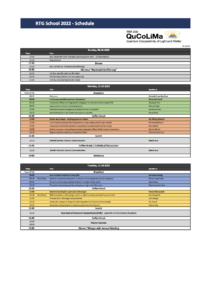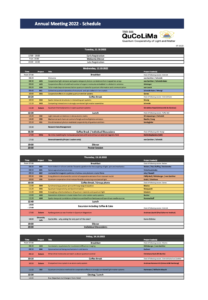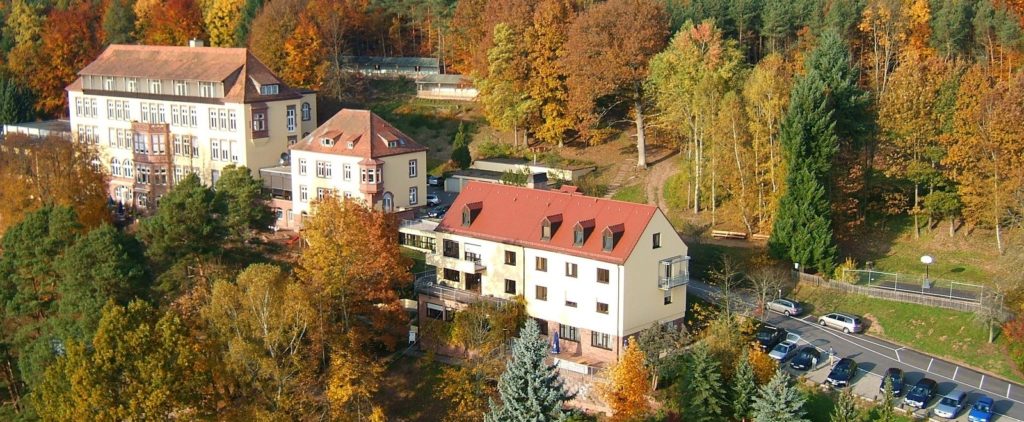Annual Meeting 2022
| RTG School: October 09 – 11, 2022 | TRR Annual Meeting: October 11 – 14, 2022 |
Programm: |
Programm: |
Minimal models for quantum thermal machines are central to understand energy exchanges at the quantum scale and the intimate connection between quantum thermodynamics and quantum information theory. In particular, one would like to determine whether quantum features, like entanglement, interactions and quantum statistics, can be beneficial to the efficiency of a thermal machine made of few quantum constituents. This research direction becomes even more fascinating in view of recent experimental progresses towards manipulating out-of-equilibrium multi-partite quantum systems, allowing for new designs and investigations of quantum thermal machines. In this talk, I will present some of our latest results concerning the advantages that open quantum systems can offer towards heat management at the nanoscale, including storing energy, controlling the flow of energy and optimization of dissipative flows.
A polariton, i.e., a light-matter state can be generated when a photon in a cavity strongly couples with the dipole moment of a molecule. Such interaction is currently heavily investigated both in terms of theory as well experiment. When choosing the frequency of the light carefully, molecular processes can be activated or inhibited. While a lot of research has focused on model Hamiltonians, some progress has also been made in terms of ab-initio formulations of the respective theory. In this project, we will implement a highly accurate quantum electrodynamics coupled-cluster methodology to study molecules in cavities and the tuning of their properties. In a further step, we will develop a respective theory to add the influence of a finite magnetic field. With both the cavity as well as the magnetic field as regulators, we will explore the control on ground and excited states as well as molecular properties.
“In this talk I discuss recent progress to use Rydberg atoms in optical tweezers as a unique platform to study quantum magnetism in and out of equilibrium. I start with a description of the platform and continue with a discussion of topics in quantum simulation of Ising and XY models, which can be addressed using these machines.
Work done in collaboration with the experimental group of A. Browaeys.”
tba
I will summarize our recent observations of discrete and continuous dissipative time crystals in a Bose-Einstein condensate strongly coupled to a single mode of a recoil resolving optical cavity.
Download List of Posters (PDF)
| # | Title | Presenter |
| 1 | Optically addressable defects in SiC | Yanis Abdedou |
| 2 | Linear optical elements based on cooperative subwavelength emitter arrays | Nico Bassler |
| 3 | Superradiance of non-interacting atoms | Manuel Bojer |
| 4 | Bosonic error correction for atomic ensemble based quantum repeaters | Subrahmanya Siddardha Chelluri |
| 5 | Cavity-induced long-range interactions in strongly correlated systems | Paul Fadler |
| 6 | Laser cooling and resonance fluorescence of trapped ion crystals | Marvin Gajewski |
| 7 | Ultradilute quantum liquid of dipolar atoms in a bilayer | Grecia Guijarro |
| 8 | Photoacid constructs for photonics | Mara Heitmann |
| 9 | Coupling of color center in 4H-SiC to mechanical vibrations | André Hochreiter |
| 10 | Methods for increasing the yield of color center generation in diamond | Alejandro Jimenez |
| 11 | Mini project in the group of Prof. Dr. Thomas Basché | Hannah Jost |
| 12 | Linked cluster expansions of a perturbed topological phase | Viktor Kott |
| 13 | Quantum-critical properties of random transverse-field Ising models extracted by quantum Monte Carlo methods | Calvin Krämer |
| 14 | Collective phenomena in a system of two interacting qubits | Robin Rüdiger Krill |
| 15 | Dynamical mean-field theory for a ferroelectric material with photon-mediated interactions | Katharina Lenk |
| 16 | High-order series expansions for Lindbladians | Lea Lenke |
| 17 | Implementation of a sub 10ps RMS jitter TDC in Xilinx 7-series FPGAs | Verena Leopold |
| 18 | Coupling a defined number of molecules to a dielectric antenna | Siwei Luo |
| 19 | Spin induced polarisation in 2-D magnetic materials | Ipsika Mohanty |
| 20 | Linked cluster expansions via hypergraph decompositions | Matthias Mühlhauser |
| 21 | New generation of microfabricated segmented ion traps for QC | Jan Müller |
| 22 | Control software stack for shuttling-based trapped-ion quantum computing | Diego Alberto Olvera Millán |
| 23 | Application of an ion based quantum processor | Helin Ozel |
| 24 | Towards digital-analog simulations using superconducting qubits and resonators | Riccardo Roma |
| 25 | Quantum correlations between two qubits coupled to a phononic bath | Sayan Roy |
| 26 | Adaptive characterisation of superconducting quantum devices | Anurag Saha Roy |
| 27 | Towards multi-photon tests of hyper-complex quantum mechanics | Ece Ipek Saruhan |
| 28 | High-order series expansions for the Dicke model | Andreas Schellenberger |
| 29 | Towards measurement-based variational quantum simulation of the multi-flavor Schwinger model with a flavor-dependent chemical potential | Stephan Schuster |
| 30 | Photo correlations of calcium trapped-ion crystals | Zyad Shehata |
| 31 | Adressed cooling of same/mixed species of ion crystals | Robin Strohmaier / Daniel Wessel |
| 32 | Flat-optics photon pair generation in the pulsed regime | Vitaliy Sultanov |
| 33 | Quantum-classical hybrid algorithms for transverse-field Ising models | Sumeet Sumeet |
| 34 | Light induced correlations in cold Dysprosium atoms | Ishan Varma |
| 35 | Stability of a magnetically levitated nanomagnet in vacuum | Vanessa Wachter |
| 36 | Quantum algorithms for the poisson equation: approaches for today and future quantum computers | Lena Wagner |
| 37 | Interacting magnons and towards analyzing phase-transitions with continuous similarity transformation: easy-axis square-lattice XXZ model | Matthias Walther |
| 38 | Equilibrium propagation and quantum machine learning | Qingshan Wang |
| 39 | Digital quantum simulation of the Ising-Dicke-Model | Yannik Weber |
| 40 | Measuring the parity of an ion crystal with a single photon | Benjamin Zenz |

Michel & Friends Hotel Franziskushöhe
Ruppertshüttener Straße 70
97816 Lohr am Main
+49 (9352) 604 – 0
Webpage
By QuCoLiMa Bus from Erlangen
– Departure: Sunday 09.10.2022, at 14:00 Großparkplatz (Bahnhof West)
By Car
– Parking: there are 130 free parking spots at the hotel
By Train
– Nearest Station: Lohr Bahnhof (Directions from train station to hotel)
– Free Shuttle Service: Bahnhof Lohr am Main – Hotel Franziskushöhe, if you wish to make use of this, please send the scheduled arrival time of your train to the TRR Office (Email: trr306-office@fau.de) by October 3; we will organize the shuttles.
